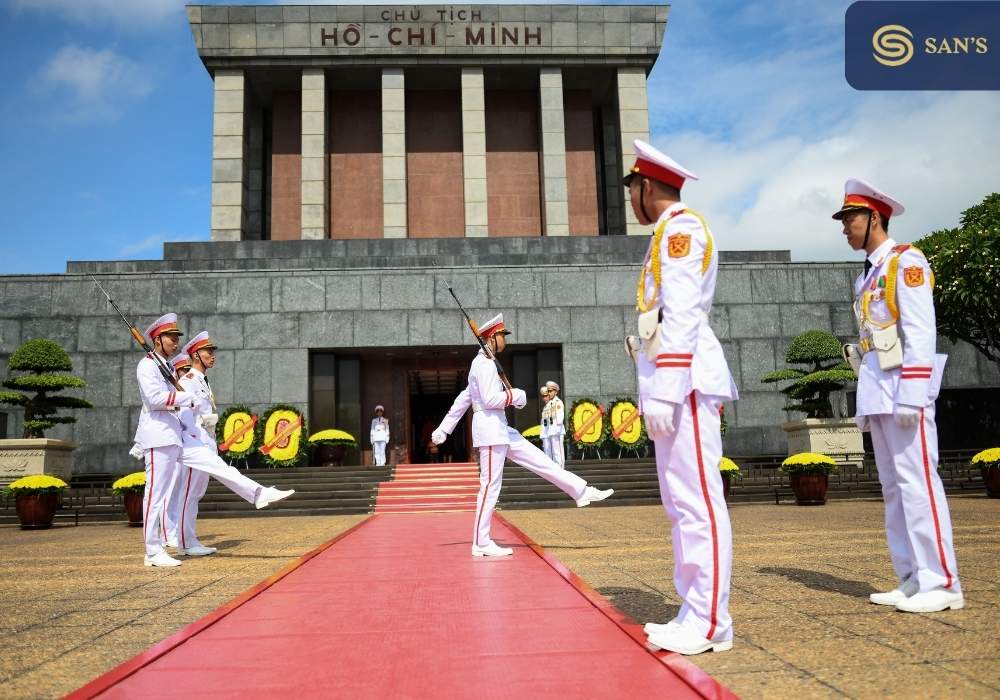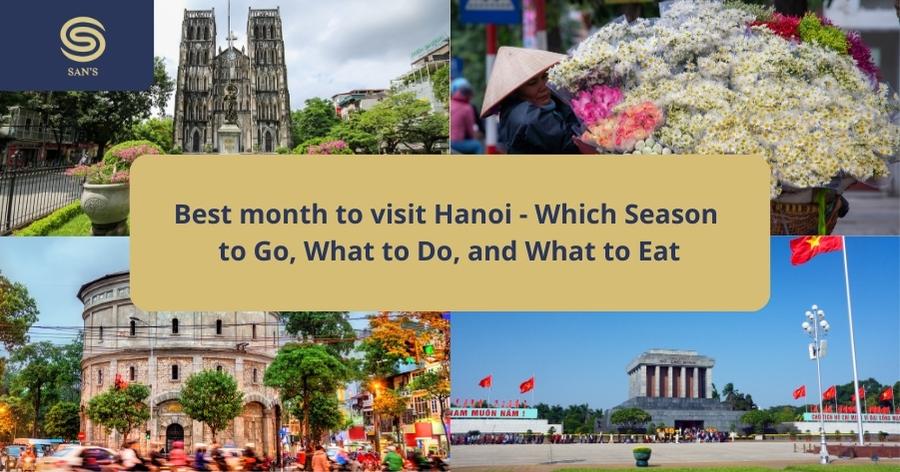In the heart of Vietnam’s capital lies a site of profound historical and cultural significance: the Ho Chi Minh Mausoleum. This article takes you on a journey inside the Ho Chi Minh Mausoleum, revealing the facets of a monument that is not only a resting place for a revered leader but also a symbol of national pride and resilience.

Ho Chi Minh, a name synonymous with Vietnamese independence and unity, played a crucial role in shaping the country’s modern history. His ideals and leadership steered Vietnam through pivotal moments, making him a figure of immense respect and adoration. The Mausoleum, located in Hanoi’s Ba Dinh Square, stands as a testament to his enduring legacy, attracting millions from across the globe.
Our exploration inside the Ho Chi Minh Mausoleum will offer a detailed look at its architectural marvels, the solemnity of its interior, and its significance beyond being a mere tourist attraction. We will delve into the heart of this iconic edifice, uncovering the layers of history and reverence that lie within its walls. This article aims to provide not just a descriptive guide, but also an insight into the deep emotional and historical connections that the Mausoleum fosters among the Vietnamese people and its visitors.
History of the Ho Chi Minh Mausoleum

The story of the Ho Chi Minh Mausoleum, an architectural and historical marvel, begins with its construction and inauguration, which are as intriguing as what lies inside the Ho Chi Minh Mausoleum itself. The decision to build this monumental structure was taken following the death of Ho Chi Minh in 1969, with the aim of honoring the leader who led Vietnam through its struggles for independence.
The construction of the Mausoleum commenced in 1973 and was completed in 1975, marking a significant period in Vietnamese history. The design of the Mausoleum draws heavy inspiration from Lenin’s Mausoleum in Moscow, yet it is uniquely Vietnamese, reflecting Ho Chi Minh’s wish for simplicity and his connection to the people. The exterior, made from gray granite, symbolizes solidity and strength, while the interior is imbued with deep cultural and historical nuances.
As one ventures inside the Ho Chi Minh Mausoleum, they encounter a solemn atmosphere that is both moving and respectful. The Mausoleum is not just a resting place for Ho Chi Minh’s body; it is a space that encapsulates his life’s work and his unbreakable bond with the Vietnamese people. Architecturally, it stands as a blend of national pride and traditional Vietnamese motifs, making it a significant site in Vietnamese culture and history.
The significance of the Mausoleum extends beyond its physical form. It represents a period of transition, struggle, and eventual triumph in Vietnamese history. For the people of Vietnam, it is a place of reverence, a symbol of their enduring respect for the leader who shaped the destiny of their nation. This historical and cultural significance is palpable to anyone who steps inside the Ho Chi Minh Mausoleum, making it a profound experience for visitors from around the world.
>>>Read more: Vietnam Woman’s Museum
The Journey Inside the Ho Chi Minh Mausoleum

Visiting the Ho Chi Minh Mausoleum is an experience steeped in respect and solemnity, beginning with the preparation for the visit. Before delving inside the Ho Chi Minh Mausoleum, visitors must adhere to a strict dress code that reflects the reverence of the site.
Modest attire is required, with covered shoulders and knees, ensuring that the decorum of this sacred place is maintained. Additionally, the Mausoleum has specific visiting hours, usually in the morning, and is closed on Mondays and Fridays for maintenance.
As one approaches the Mausoleum, the striking exterior architecture commands attention. The building’s façade, made of grey granite, exudes a sense of strength and solemnity. The structure’s square shape and the towering flagpole in front add to its grandeur and imposing presence. This architectural design is not only a tribute to Ho Chi Minh but also a reflection of Vietnamese cultural aesthetics.
Upon entering inside the Ho Chi Minh Mausoleum, visitors are enveloped in a solemn atmosphere. Silence is observed strictly as a sign of respect, and the slow, orderly movement of the crowd reflects the solemnity of the visit. The interior is stark yet poignant, designed to focus attention on the central feature – the embalmed body of Ho Chi Minh, displayed in a glass sarcophagus. This serene environment allows visitors to reflect on the life and legacy of the leader who lies in eternal rest here.
The interior structure of the Mausoleum is simple yet elegant, with minimalistic design elements that emphasize reverence and respect. The embalmed body of Ho Chi Minh, the focal point of the interior, is preserved in a dimly lit chamber, guarded by military personnel. This poignant sight is a powerful reminder of Ho Chi Minh’s enduring presence in the hearts of the Vietnamese people.
In summary, the journey inside the Ho Chi Minh Mausoleum is a profound experience, offering a glimpse into the heart of Vietnamese reverence for their beloved leader. It’s an encounter that leaves visitors with a deeper understanding of Vietnam’s history and the immense respect Ho Chi Minh commands among his people.
Symbolism and Artifacts

The symbolism embedded in the design and location of the Ho Chi Minh Mausoleum is as profound as the artifacts and inscriptions housed inside the Ho Chi Minh Mausoleum. Situated in Ba Dinh Square, where Ho Chi Minh declared Vietnam’s independence in 1945, the Mausoleum is not just a final resting place but a symbol of the nation’s freedom and resilience.
The structure’s imposing yet simple design reflects Ho Chi Minh’s own principles – strength combined with humility, grandeur mixed with approachability.
Inside the Ho Chi Minh Mausoleum, visitors encounter various artifacts that hold deep historical significance. Among these are personal items that belonged to Ho Chi Minh, giving a glimpse into the life of the leader who was known for his modesty and connection with the common people.
Each artifact, be it a pen, a book, or a piece of clothing, tells a story of the leader’s life, his work, and his profound influence on the nation’s history.
Additionally, the Mausoleum is adorned with quotes and inscriptions that reflect Ho Chi Minh’s ideologies and teachings. These inscriptions, deeply meaningful and thought-provoking, resonate with the principles of independence, unity, and resilience that Ho Chi Minh championed. They serve not just as reminders of his vision for Vietnam but also as a source of inspiration for future generations.
The careful arrangement of these artifacts and inscriptions inside the Ho Chi Minh Mausoleum creates an atmosphere of reflection and reverence. They symbolize the enduring legacy of Ho Chi Minh and the unbreakable spirit of the Vietnamese people. For visitors, these elements provide a deeper understanding of Vietnam’s history and the pivotal role Ho Chi Minh played in shaping it. The Mausoleum, in its entirety, stands as a powerful testament to a leader’s life and a nation’s journey towards independence and unity.
As we conclude our exploration, the significance of the Ho Chi Minh Mausoleum in Vietnamese history and culture becomes ever more apparent. Journeying inside the Ho Chi Minh Mausoleum offers more than just a glimpse into a historical monument; it provides a profound understanding of the enduring legacy of Ho Chi Minh and the deep reverence he commands in the hearts of the Vietnamese people.
The Mausoleum is not merely a structure of bricks and mortar; it is a symbol of Vietnam’s struggle for independence, unity, and self-determination. It stands as a testament to the life and ideals of Ho Chi Minh, whose vision continues to guide and inspire. The solemnity and respect experienced by visitors inside the Ho Chi Minh Mausoleum reflect the deep emotional and historical connections that the site fosters, making it a unique and invaluable part of Vietnam’s national heritage.

The importance of preserving such historical sites cannot be overstated. They are repositories of history, culture, and collective memory, serving as bridges connecting past and present generations. The Ho Chi Minh Mausoleum, in particular, plays a crucial role in educating and reminding visitors of the sacrifices made for independence and the importance of maintaining the values for which Ho Chi Minh stood.
In preserving the Mausoleum, we not only honor the memory of a great leader but also ensure that future generations can continue to learn from and be inspired by the rich history and heritage it represents. It is a beacon of national pride and a solemn reminder of the journey a nation undertook to achieve its place in the world. As such, inside the Ho Chi Minh Mausoleum lies not just the embodiment of Ho Chi Minh’s legacy but the heart and soul of Vietnam itself.
FAQs about the Ho Chi Minh Mausoleum
- What are the visiting hours for the Ho Chi Minh Mausoleum?
- The Mausoleum is typically open to visitors in the morning, except on Mondays and Fridays. It’s advisable to check the current visiting hours before planning your visit as they can vary.
- Is there a dress code for visiting the Mausoleum?
- Yes, visitors are expected to dress modestly out of respect. This includes covering shoulders and knees. Hats should be removed before entering the Mausoleum.
- Can I take photographs inside the Ho Chi Minh Mausoleum?
- Photography, video recording, and carrying bags inside the Mausoleum are not allowed. There are facilities outside where you can store your belongings during your visit.
- Is there an entrance fee to visit the Mausoleum?
- Visiting the Ho Chi Minh Mausoleum is free of charge. However, donations are accepted and used for maintenance.
- How long does a visit to the Mausoleum usually take?
- A visit can take anywhere from 15 minutes to an hour, depending on the crowd and the time spent inside.
- Are there any restricted items or behaviors inside the Mausoleum?
- Smoking, eating, and loud talking are not permitted inside the Mausoleum. Visitors are also required to maintain a respectful demeanor.
- What is the best time of year to visit the Mausoleum?
- The Mausoleum can be visited year-round, but the best time is during the cooler months from November to April.
- Can people with disabilities access the Ho Chi Minh Mausoleum?
- Yes, the Mausoleum is accessible to people with disabilities. There are ramps and assistance available if needed.
- Is it possible to see the embalmed body of Ho Chi Minh?
- Yes, visitors can view the embalmed body of Ho Chi Minh, which lies in a glass case inside the Mausoleum.
- What should I do if I have a large bag or backpack with me?
- There is a storage facility near the Mausoleum where visitors can store large bags and backpacks before entering.
>>>Read more: Top Places to see in Hanoi





